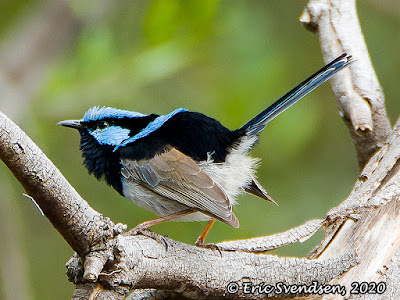Pick your poison - ISO or shutter speed
 |
| Australian Fairy Wren in pursuit of a mate. |
One of the most fundamental aspects is choosing the right shutter speed. Low shutter speeds often rewards the shooter with unusable, blurry images. Vibration mitigation technology helps reduce blur from camera movement but does nothing for the blur caused by subject motion. Even tiny hints of blur can render an otherwise superb opportunity moot. Fortunately, there are a host of solutions to overcome this challenge.
There are equipment choices that will help in the bid to sequester decent shutter speeds. This starts out with lenses that allow low minimum apertures when zoomed in. As much as such items can be touted and praised for such ability, their size and price puts them well out of the reach of 99% of us. For example, Nikon's 600 mm f/4 lens currently goes for around $16,600 (on sale now for the reasonable price of $15,999 - that's a savings of over $600 folks!). The rest of us use 100-400 mm or 150-600 mm zoom lenses that, while pricey, still allow you to fill the car with gas and bring home a few groceries now and again.
The best solution, by far, is to befriend your ISO function. My general mantra on this subject is to shoot low and slow; pick a low ISO and use a low shutter speed. This works well for landscapes but is disastrous when photographing wildlife. I like to use shutter speeds of 1/250th of a second when shooting most sporting events, but wildlife often benefits from using even faster values. In the end, there is a modest amount of trial and error, and equipment plays a role in the final outcome too.
The above photo was taken using an ISO of 400 with a shutter speed of 1/125th of a second. Although a tad slow, the subject froze nicely for a brief moment of time. I also took 30 or 40 shots at 10 frames a second and used continuous spot focusing to track the amorous avian. Below I used an ISO of 640 and a shutter speed of 1/2500th of a second. Same idea with shots, but had focus tracking turned on. Digital capture allows immediate review of your success, use this amazing advantage wisely. Shoot, push play, zoom in, and make sure your images are coming out the way you want. If your shutter speed is too slow, increase ISO and shutter speed accordingly.
 |
| Tree Swallow photographed in flight. |
The best suggestion I can make is to play with your settings. Start with an ISO of 100 on aperture priority with the aperture wide open. Check your shutter speed. Take a few shots. Press play and zoom in. Bump ISO up to 200 and repeat. Then 400 and 800. Try 1600 and even 3200. Heck, throw in the towel and go all the way to 6400 or even 12800 (you may have to turn on the ISO extension in your camera's function menu). Play, shoot, check, learn. It's that easy.
Thanks for reading. www.ericspix.com Eric Svendsen



Comments
Post a Comment